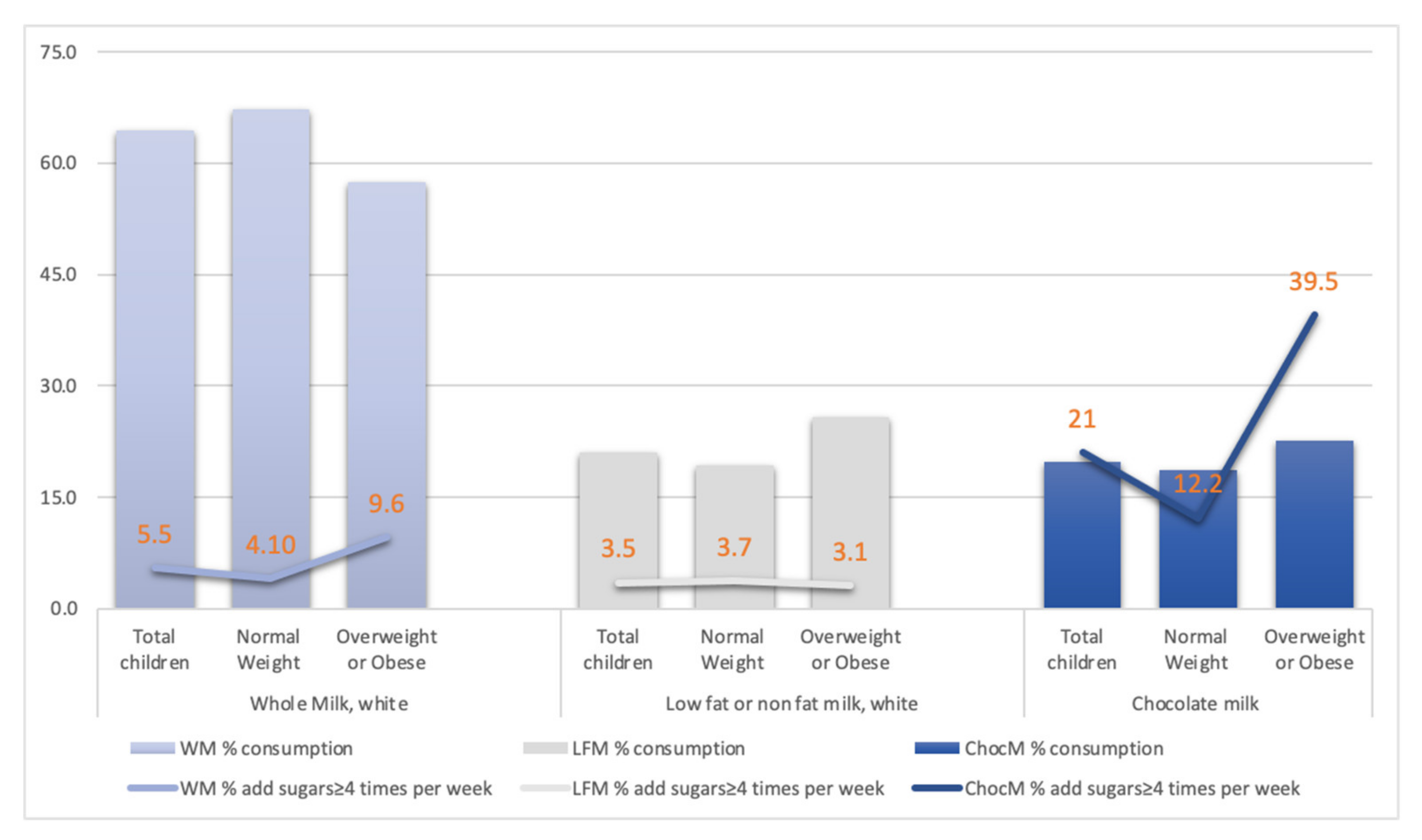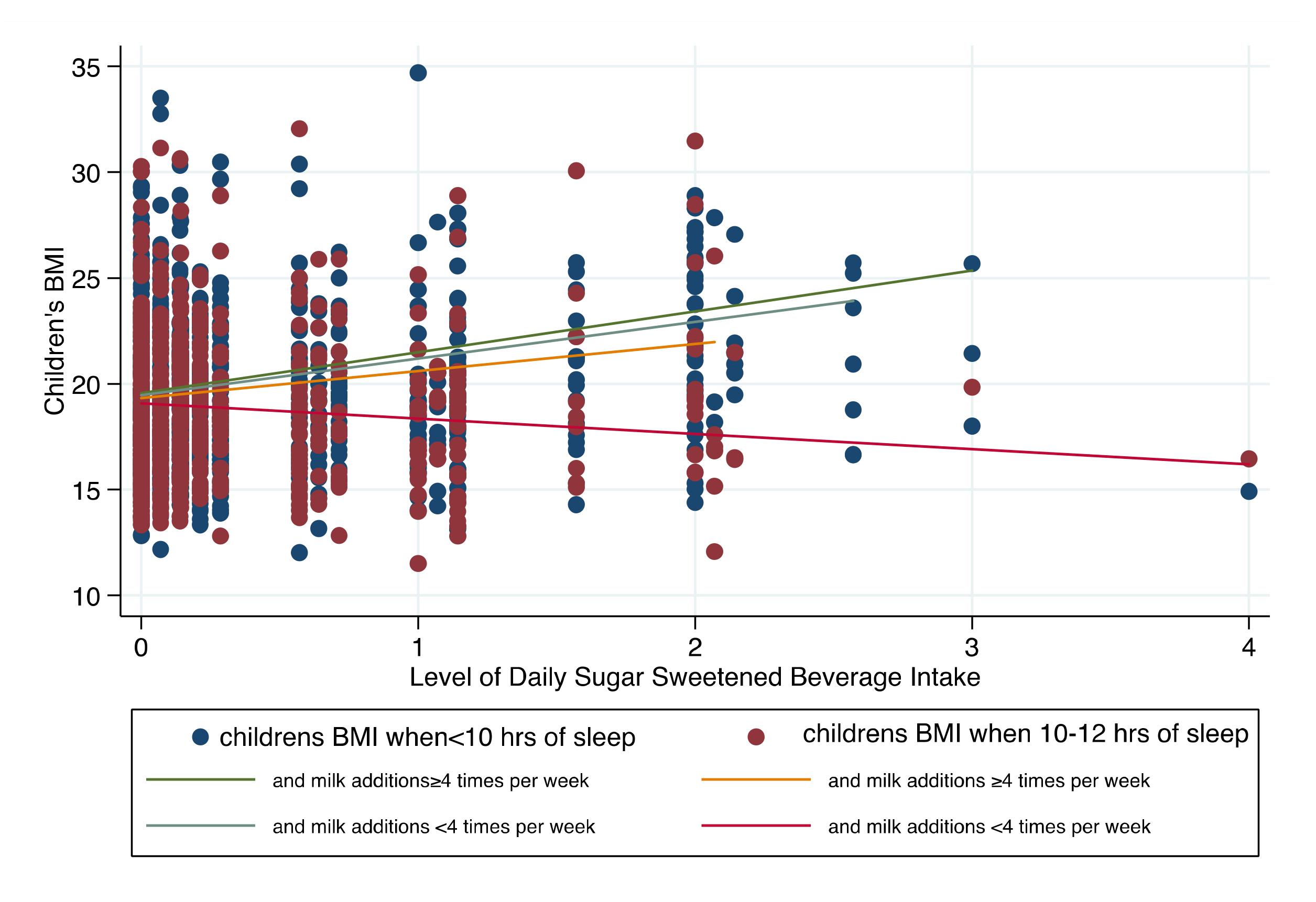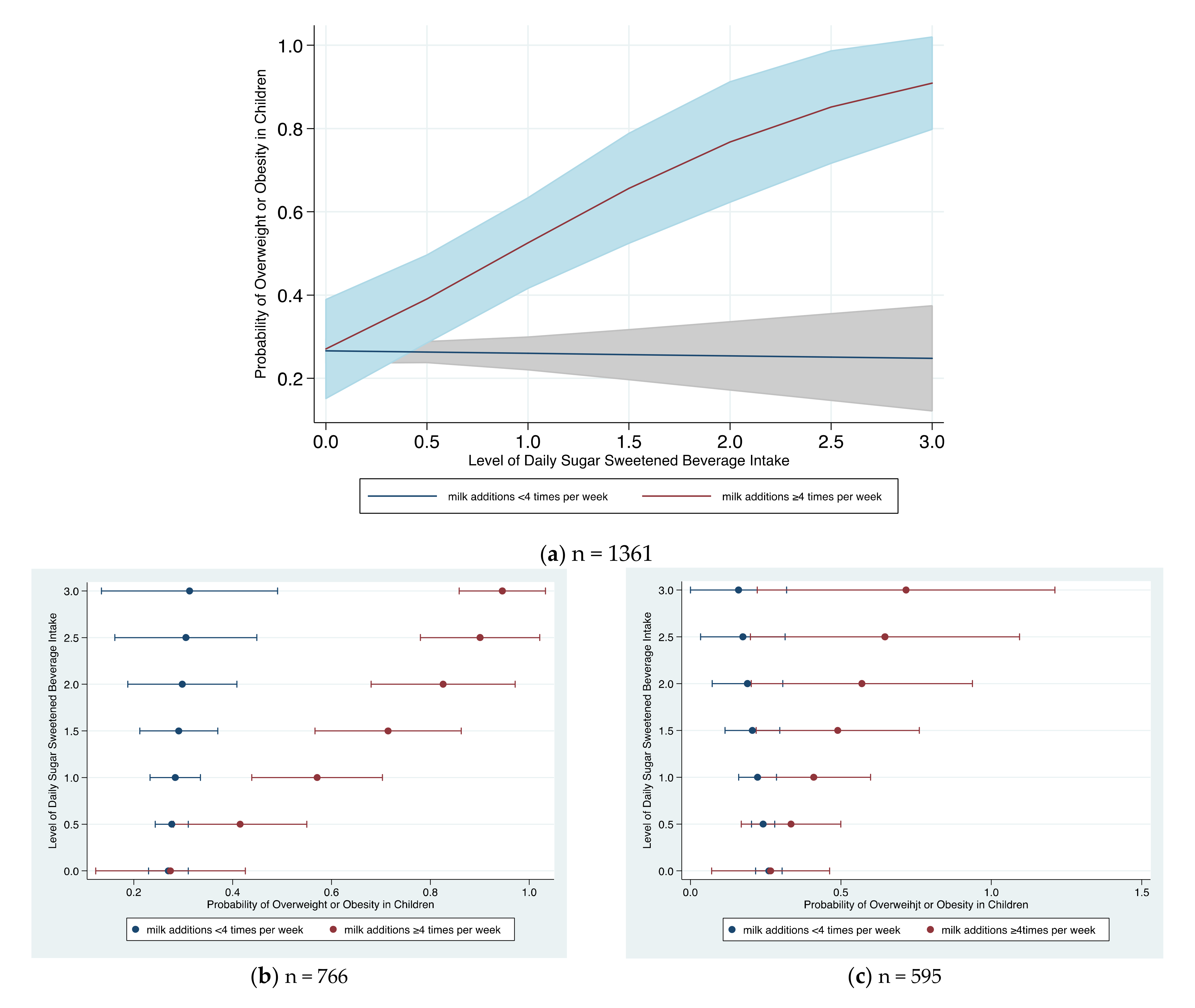The Association of Sugar-Sweetened Beverages to Children’s Weights Status Is Moderated by Frequency of Adding Sugars and Sleep Hours
Abstract
:1. Introduction
2. Materials and Methods
2.1. Bioethics
2.2. Nutrition and Anthropometric Data
2.3. Total Sleep and Other Variables
2.4. Statistical Analysis
3. Results
4. Discussion
5. Conclusions
Author Contributions
Funding
Institutional Review Board Statement
Informed Consent Statement
Data Availability Statement
Acknowledgments
Conflicts of Interest
References
- Vartanian, L.R.; Schwartz, M.B.; Brownell, K.D. Effects of soft drink consumption on nutrition and health: A systematic review and meta-analysis. Am. J. Public Health 2007, 97, 667–675. [Google Scholar] [CrossRef] [PubMed]
- Te Morenga, L.; Mallard, S.; Mann, J. Dietary sugars and body weight: Systematic review and meta-analyses of randomised controlled trials and cohort studies. BMJ 2012, 346, e7492. [Google Scholar] [CrossRef] [PubMed] [Green Version]
- Spinelli, A.; Buoncristiano, M.; Kovacs, V.A.; Yngve, A.; Spiroski, I.; Obreja, G.; Starc, G.; Pérez, N.; Rito, A.I.; Kunešová, M.; et al. Prevalence of Severe Obesity among Primary School Children in 21 European Countries. Obes. Facts 2019, 12, 244–258. [Google Scholar] [CrossRef] [PubMed]
- World Health Organization. Guideline: Sugars Intake for Adults and Children; World Health Organization: Geneva, Switzerland, 2015; Available online: https://apps.who.int/iris/handle/10665/149782 (accessed on 28 June 2022).
- Scientific Advisory Committee on Nutrition (SACN). Carbohydrates and Health; TSO: London, UK, 2015.
- Welsh, J.A.; Wang, Y.; Figueroa, J.; Brumme, C. Sugar intake by type (added vs. naturally occurring) and physical form (liquid vs. solid) and its varying association with children’s body weight, NHANES 2009–2014. Pediatr. Obes. 2018, 13, 213–221. [Google Scholar] [CrossRef]
- Magriplis, E.; Michas, G.; Petridi, E.; Chrousos, G.P.; Roma, E.; Benetou, V.; Cholopoulos, N.; Micha, R.; Panagiotakos, D.; Zampelas, A. Dietary Sugar Intake and Its Association with Obesity in Children and Adolescents. Children 2021, 8, 676. [Google Scholar] [CrossRef]
- Bray, G.A.; Popkin, B.M. Dietary sugar and body weight: Have we reached a crisis in the epidemic of obesity and diabetes?: Health be damned! Pour on the sugar. Diabetes Care 2014, 37, 950–956. [Google Scholar] [CrossRef] [Green Version]
- Ahmad, R.; Mok, A.; Rangan, A.M.; Louie, J.C.Y. Association of free sugar intake with blood pressure and obesity measures in Australian adults. Eur. J. Nutr. 2020, 59, 651–659. [Google Scholar] [CrossRef]
- Flieh, S.M.; Moreno, L.A.; Miguel-Berges, M.L.; Stehle, P.; Marcos, A.; Molnár, D.; Widhalm, K.; Béghin, L.; De Henauw, S.; Kafatos, A.; et al. Free Sugar Consumption and Obesity in European Adolescents: The HELENA Study. Nutrients 2020, 12, 3747. [Google Scholar] [CrossRef]
- Gutierrez, E.; Metcalfe, J.J.; Prescott, M.P. The Relationship between Fluid Milk, Water, and 100% Juice and Health Outcomes among Children and Adolescents. Nutrients 2022, 14, 1892. [Google Scholar] [CrossRef]
- Dello Russo, M.; Ahrens, W.; De Henauw, S.; Eiben, G.; Hebestreit, A.; Kourides, Y.; Lissner, L.; Molnar, D.; Moreno, L.A.; Pala, V.; et al. The Impact of Adding Sugars to Milk and Fruit on Adiposity and Diet Quality in Children: A Cross-Sectional and Longitudinal Analysis of the Identification and Prevention of Dietary- and Lifestyle-Induced Health Effects in Children and Infants (IDEFICS) Study. Nutrients 2018, 10, 1350. [Google Scholar]
- Dashti, H.S.; Scheer, F.A.; Jacques, P.F.; Lamon-Fava, S.; Ordovás, J.M. Short sleep duration and dietary intake: Epidemiologic evidence, mechanisms, and health implications. Adv. Nutr. 2015, 6, 648–659. [Google Scholar] [CrossRef] [PubMed]
- Kjeldsen, J.S.; Hjorth, M.F.; Andersen, R.; Michaelsen, K.F.; Tetens, I.; Astrup, A.; Chaput, J.P.; Sjödin, A. Short sleep duration and large variability in sleep duration are independently associated with dietary risk factors for obesity in Danish school children. Int. J. Obes. 2014, 38, 32–39. [Google Scholar] [CrossRef] [PubMed]
- Kanellopoulou, A.; Notara, V.; Magriplis, E.; Antonogeorgos, G.; Rojas-Gil, A.P.; Kornilaki, E.N.; Lagiou, A.; Yannakoulia, M.; Panagiotakos, D.B. Sleeping patterns and childhood obesity: An epidemiological study in 1728 children in Greece. J. Clin. Sleep Med. 2021, 17, 1093–1101. [Google Scholar] [CrossRef] [PubMed]
- Magriplis, E.; Farajian, P.; Panagiotakos, D.B.; Risvas, G.; Zampelas, A. The relationship between behavioral factors, weight status and a dietary pattern in primary school aged children: The GRECO study. Clin. Nutr. 2019, 38, 310–316. [Google Scholar] [CrossRef] [PubMed]
- Gradisar, M.; Gardner, G.; Dohnt, H. Recent worldwide sleep patterns and problems during adolescence: A review and meta-analysis of age, region, and sleep. Sleep Med. 2011, 12, 110–118. [Google Scholar] [CrossRef] [PubMed]
- Notara, V.; Magriplis, E.; Prapas, C.; Antonogeorgos, G.; Rojas-Gil, A.P.; Kornilaki, E.N.; Lagiou, A.; Panagiotakos, D.B. Parental weight status and early adolescence body weight in association with socioeconomic factors. J. Educ. Health Promot. 2019, 8, 77. [Google Scholar]
- Serra-Majem, L.; Ribas, L.; Ngo, J.; Ortega, R.M.; García, A.; Pérez-Rodrigo, C.; Aranceta, J. Food, youth and the Mediterranean diet in Spain. Development of KIDMED, Mediterranean Diet Quality Index in children and adolescents. Public Health Nutr. 2004, 7, 931–935. [Google Scholar] [CrossRef]
- Cole, T.J.; Lobstein, T. Extended international (IOTF) body mass index cut-offs for thinness, overweight and obesity. Pediatr. Obes. 2012, 7, 284–294. [Google Scholar] [CrossRef]
- Paruthi, S.; Brooks, L.J.; D’Ambrosio, C.; Hall, W.A.; Kotagal, S.; Lloyd, R.M.; Malow, B.A.; Maski, K.; Nichols, C.; Quan, S.F.; et al. Consensus Statement of the American Academy of Sleep Medicine on the Recommended Amount of Sleep for Healthy Children: Methodology and Discussion. J. Clin. Sleep Med. 2016, 12, 1549–1561. [Google Scholar] [CrossRef]
- Wing, Y.K.; Li, S.X.; Li, A.M.; Zhang, J.; Kong, A.P. The effect of weekend and holiday sleep compensation on childhood overweight and obesity. Pediatrics 2009, 124, e994–e1000. [Google Scholar] [CrossRef]
- Antonogeorgos, G.; Grigoropoulou, D.; Papadimitriou, A.; Priftis, K.; Anthracopoulos, M.; Nikolaidou, P.; Panagiotakos, D. Validation of a food frequency questionnaire designed for children 10–12 years: The Panacea-FFQ. Perioper. Nurs. 2013, 2, 40–54. [Google Scholar]
- Wang, H.; Jeong, H.; Kim, N.H.; Kang, Y.; Hwang, K.; Lee, H.; Hong, J.H.; Oh, K.S. Association between beverage intake and obesity in children: The Korea National Health and Nutrition Examination Survey (KNHANES) 2013–2015. Nutr. Res. Pract. 2018, 12, 307–314. [Google Scholar] [CrossRef] [PubMed]
- Felső, R.; Lohner, S.; Hollódy, K.; Erhardt, É.; Molnár, D. Relationship between sleep duration and childhood obesity: Systematic review including the potential underlying mechanisms. Nutr. Metab. Cardiovasc. Dis. 2017, 27, 751–761. [Google Scholar] [CrossRef]
- Kit, B.K.; Carroll, M.D.; Ogden, C.L. Low-fat milk consumption among children and adolescents in the United States, 2007–2008. NCHS Data Brief 2011, 75, 1–8. [Google Scholar]
- Duffey, K.J.; Huybrechts, I.; Mouratidou, T.; Libuda, L.; Kersting, M.; De Vriendt, T.; Gottrand, F.; Widhalm, K.; Dallongeville, J.; Hallström, L.; et al. Beverage consumption among European adolescents in the HELENA study. Eur. J. Clin. Nutr. 2012, 66, 244–252. [Google Scholar] [CrossRef] [Green Version]
- Brophy, S.; Cooksey, R.; Gravenor, M.B.; Mistry, R.; Thomas, N.; Lyons, R.A.; Williams, R. Risk factors for childhood obesity at age 5, analysis of the millennium cohort study. BMC Public Health 2009, 9, 467. [Google Scholar] [CrossRef] [PubMed] [Green Version]
- Fidler Mis, N.; Braegger, C.; Bronsky, J.; Campoy, C.; Domellöf, M.; Embleton, N.D.; Hojsak, I.; Hulst, J.; Indrio, F.; Lapillonne, A.; et al. Sugar in Infants, Children and Adolescents: A Position Paper of the European Society for Paediatric Gastroenterology, Hepatology and Nutrition Committee on Nutrition. J. Pediatr. Gastroenterol. Nutr. 2017, 65, 681–696. [Google Scholar] [CrossRef] [Green Version]
- Erickson, J.; Slavin, J. Total, Added, and Free Sugars: Are Restrictive Guidelines Science-Based or Achievable? Nutrients 2015, 7, 2866–2878. [Google Scholar] [CrossRef]
- Ash, T.; Agaronov, A.; Young, T.; Aftosmes-Tobio, A.; Davison, K.K. Family-based childhood obesity prevention interventions: A systematic review and quantitative content analysis. Int. J. Behav. Nutr. Phys. Act. 2017, 14, 113. [Google Scholar] [CrossRef]
- Chaput, J.P. Sleep patterns, diet quality and energy balance. Physiol. Behav. 2014, 134, 86–91. [Google Scholar] [CrossRef]



| Total Children n = 1361 | Average Sleep Hours per Day 1 Mean (sd): 9.7 (1.0) | p-Value | ||
|---|---|---|---|---|
| <10 Hours n = 766 (56.3%) | ≥10 Hours n = 595 (43.7%) | |||
| Age, mean (sd) | 11.2 (0.8) | 11.2 (0.8) | 11.1 (0.8) | 0.089 |
| Sex, n (%) | 0.004 | |||
| Males, n% | 612 (45.0) | 371 (60.6) | 241 (39.4) | |
| Females, n% | 749 (55.0) | 395 (52.7) | 354 (47.3) | |
| BMI, kg/m2, mean (sd) | 19.3 (3.4) | 19.5 (3.5) | 18.9 (3.3) | 0.001 |
| Weight status 2 | 0.068 | |||
| Normal weight | 979 (71.9) | 536 (54.8) | 443 (45.3) | |
| Overweight and obese | 382 (28.1) | 230 (60.2) | 152 (39.8) | |
| KIDMED score, median (IQR) | 4.0 (3.0, 6.0) | 4.0 (3.0, 6.0) | 5 (3.0, 6.0) | <0.001 |
| Milk, unsweetened (servings per day) | 1.0 (0.6, 2.0) | 1.0 (0.6, 2.0) | 1.0 (1.0, 2.0) | 1.0 |
| Sugar-Sweetened Beverage frequency per week, median (IQR) | 1.0 (0.5, 4.0) | 1.0 (0.5, 4.5) | 1.0 (0, 2.0) | 0.004 |
| Milk additions, ≥4 times per week | 105 (7.7) | 70 (9.1) | 35 (5.9) | 0.026 |
| Daily walking in min per day, >60 min | 186 (13.7) | 100 (53.8) | 86 (46.2) | 0.456 |
| Postsecondary or higher third level education 3, n (%) | 407 (45.5) | 232 (45.3) | 175 (45.8) | 0.884 |
| Children’s Residence | 0.010 | |||
| Urban | 891 (65.5) | 524 (58.8) | 367 (41.2) | |
| Semi-urban | 470 (34.5) | 242 (51.5) | 228 (43.7) | |
| Total Children | Children Who Sleep <10 Hours per Day | Children Who Sleep ≥10–12 Hours per Day | ||||
|---|---|---|---|---|---|---|
| Weight Status | Odds Ratio 1 | [95% Confidence Interval] | Odds Ratio 1 | [95% Confidence Interval] | Odds Ratio 1 | [95% Confidence Interval] |
| SSB 2 | 0.97 | 0.75–1.25 | 1.08 | 0.78–1.49 | 0.81 | 0.53–1.26 |
| Milk additions ≥4 times per week | 1.02 | 0.54–1.93 | 1.02 | 0.45–2.33 | 1.03 | 0.36–2.91 |
| Milk additions ≥4 times per week SSB 2 | 3.18 | 1.71–5.91 | 3.49 | 1.58–7.71 | 2.37 | 0.79–7.14 |
| Sweets, frequency per week | 0.83 | 0.60–1.16 | 0.89 | 0.59–1.35 | 0.67 | 0.37–1.22 |
| Age, years | 0.90 | 0.76–1.05 | 0.96 | 0.77–1.19 | 0.86 | 0.67–1.09 |
| Sex, females vs. males | 0.65 | 0.51–0.84 | 0.52 | 0.38–0.73 | 0.86 | 0.59–1.26 |
| KIDMED score | 0.96 | 0.90–1.01 | 0.96 | 0.89–1.04 | 0.95 | 0.87–1.04 |
| Daily walking in min per day, >60 min | 0.73 | 0.50–1.07 | 0.71 | 0.42–1.19 | 0.77 | 0.44–1.34 |
| Residence 3 | 1.46 | 1.14–1.89 | 1.83 | 1.30–2.57 | 1.12 | 0.76–1.64 |
| Sleep hours category | 0.85 | 0.66–1.10 | ||||
Publisher’s Note: MDPI stays neutral with regard to jurisdictional claims in published maps and institutional affiliations. |
© 2022 by the authors. Licensee MDPI, Basel, Switzerland. This article is an open access article distributed under the terms and conditions of the Creative Commons Attribution (CC BY) license (https://creativecommons.org/licenses/by/4.0/).
Share and Cite
Magriplis, E.; Kanellopoulou, A.; Notara, V.; Antonogeorgos, G.; Rojas-Gil, A.P.; Kornilaki, E.N.; Lagiou, A.; Zampelas, A.; Panagiotakos, D.B. The Association of Sugar-Sweetened Beverages to Children’s Weights Status Is Moderated by Frequency of Adding Sugars and Sleep Hours. Children 2022, 9, 1088. https://doi.org/10.3390/children9071088
Magriplis E, Kanellopoulou A, Notara V, Antonogeorgos G, Rojas-Gil AP, Kornilaki EN, Lagiou A, Zampelas A, Panagiotakos DB. The Association of Sugar-Sweetened Beverages to Children’s Weights Status Is Moderated by Frequency of Adding Sugars and Sleep Hours. Children. 2022; 9(7):1088. https://doi.org/10.3390/children9071088
Chicago/Turabian StyleMagriplis, Emmanuella, Aikaterini Kanellopoulou, Venetia Notara, George Antonogeorgos, Andrea Paola Rojas-Gil, Ekaterina N Kornilaki, Areti Lagiou, Antonis Zampelas, and Demosthenes B Panagiotakos. 2022. "The Association of Sugar-Sweetened Beverages to Children’s Weights Status Is Moderated by Frequency of Adding Sugars and Sleep Hours" Children 9, no. 7: 1088. https://doi.org/10.3390/children9071088
APA StyleMagriplis, E., Kanellopoulou, A., Notara, V., Antonogeorgos, G., Rojas-Gil, A. P., Kornilaki, E. N., Lagiou, A., Zampelas, A., & Panagiotakos, D. B. (2022). The Association of Sugar-Sweetened Beverages to Children’s Weights Status Is Moderated by Frequency of Adding Sugars and Sleep Hours. Children, 9(7), 1088. https://doi.org/10.3390/children9071088








